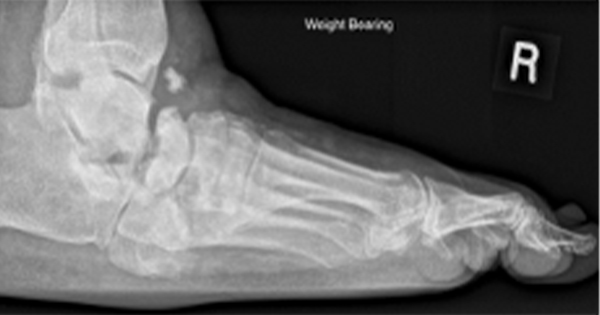Foot ulcers occur in about 6% of people with diabetes in the US who are covered by Medicare insurance for older people (Margolis et al, 2011) and there is a 2.5% prevalence in the UK (Abbott et al, 2002), and diabetic foot osteomyelitis (DFO) may be present in a large proportion of these ulcers (around 20%) (Lavery et al, 2009). The presence of DFO has been associated with an increased rate of above-ankle amputation (Saltoglu et al, 2015). Despite a high incidence and poor outcomes, current guidelines provide only general recommendations for the management of DFO and cite a level of evidence categorised as ‘low’ (Lipsky et al 2012). In the absence of high-quality data on DFO outcomes with various treatment approaches, there is substantial variation in practice. Figure 1 illustrates two examples of DFO.
Various centres appear to prefer a primarily surgical approach (Shaikh et al, 2013), a primarily medical (non-surgical) approach (Game and Jeffcoate, 2008; Senneville et al, 2008), or some combination thereof (Embil et al, 2006).
The authors have published a study (Allahabadi et al, 2016) describing an attempt to establish some consensus of expert opinions on the surgical management of DFO that might help clinicians until better quality research becomes available. The panelists had substantial clinical and/or research expertise in DFO from the fields of orthopaedic, podiatric, vascular, general and plastic surgery. The initial panel comprised 13 surgeons, the majority of whom were podiatric surgeons. A fourteenth panelist (a surgeon) was added after the initial questionnaire.
Open-ended questionnaires were sent to the panelists to find out about current practices and opinions on various topics relevant to the surgical management of DFO. All questions concerned patients with DFO without significant arterial insufficiency or metal-in-bone hardware. Panelists provided responses through either written statements or verbal responses during a telephone interview. The responses from this initial open-ended questionnaire were used to write 63 initial statements.
Delphi methodology was then used to grade each statement. Delphi methodology is an interactive process in which a panel of experts anonymously responds to a series of questionnaires. Panelists graded their agreement with each of the statements using a nine-point Likert scale, where 1=completely disagree, 5=neutral, and 9=completely agree. Additional comments or explanations could be given for each statement. Consensus was defined as an average panelist Likert score of ≥7. Each round of responses was followed by feedback in which each panelist received a record of their individual response and the median response for each item. After this feedback, panelists were asked to vote again on all statements that had a mean score that ranged from 6.50 to 6.99. If written feedback from the panelists suggested changes that might lead to consensus agreement, items were modified. In the first round of voting, 33 items reached consensus agreement, and five additional statements reached consensus after a second and third round of voting.
Initial diagnosis and the selection of patients for surgical management
There was consensus on seven statements related to initial diagnosis and the selection of patients for surgical management of DFO, including:
- The presence of chronically exposed trabecular bone is sufficient for a diagnosis for DFO
- Magnetic resonance imaging (MRI) or bone biopsy were useful second-line diagnostic modalities to confirm a diagnosis of DFO that was uncertain after clinical examination and X-rays alone
- Primarily surgical management is preferable for a patient with evidence of systemic toxicity, a prosthetic heart valve, or evidence of an open or infected joint space, necrotic bone, chronically exposed trabecular bone, substantial cortical destruction or other bone fragmentation seen on X-ray.
Intraoperative management
Consensus was reached on 15 statements related to intraoperative management, including recommending:
- Operative management of deep soft tissue infections 3–7 days before definitive resection of bone
- Considering negative pressure dressings with instillation therapy for concomitant soft tissue infection
- Use a power saw to resect bone until the surgeon sees a grossly healthy-appearing margin
- Collect operative specimens of grossly abnormal bone and the proximal-most resected bone (the bone margin) and send for both histopathology and culture
- Consider adjunctive foot surgery procedures (including tendo-achilles lengthening) to address biomechanical issues, to support wound healing, and reduce the risk of reulceration or transfer ulcers.
The panelists considered partial ostectomy of bone affected with DFO an acceptable alternative to metatarsal ray amputation.
Postoperative management
On the subject of postoperative management of DFO, the panelists reached consensus on 10 statements, recommending:
- Electing primary closure when possible, or using negative pressure wound therapy, absorbent, non-adherent dressings, or autologous skin grafting when it is not possible
- Pressure offloading of the affected foot is important; this may be accomplished with a removable cast walker or posterior splints, or — if DFO is limited to a toe or associated with a dorsal foot wound only – an open-toed shoe with multidensity inserts
- When needed, consider additional support in the form of canes, crutches or rollator-type walkers
- Postoperatively, if any of the intraoperative specimens sent for pathology and microbiology had findings compatible with bone infection, give postoperative antibiotic treatment for six or more weeks.
Panelists were unable to reach consensus agreement on when the initial dressing should be removed after the operation, with responses ranging from 24 hours to several days.
Other issues
Panelists reached consensus on six statements on other topics relevant to the surgical management of DFO:
- A multidisciplinary/interdisciplinary approach improves treatment outcomes and reduces the rate of leg amputations
- Establishing biomechanical stability in the foot is critical for wound healing and minimising reulceration
- Inadequate extent of bone resection is an important cause of DFO treatment failure.
- There are no widely-accepted definitions of treatment failure or success and no guidelines for monitoring the post-operative treatment response.
- There are no standard definitions of treatment failure or success
- The anticipated amputation rate should be <10% when diabetic foot osteomyelitis is not associated with prosthetic hardware or peripheral artery disease.
Conclusion
This study was undertaken because of the variations in practice that stem from the lack of well-founded evidence concerning the surgical management of DFO. Despite the high and increasing incidence of DFO, and the high proportion of cases that require surgical management, we lack sufficient well-designed clinical trials. At the time of our study, we could find only two published randomised controlled trials specific to DFO, and they involved 40 and 52 patients (Lázaro-Martínez et al, 2014; Tone et al, 2015). In comparison, recent observational series and randomised trials for patients with malignant melanoma — a condition with a slightly lower incidence than DFO — have included 2,100 and 423 patients (Kim et al, 2015; Long et al, 2015). Although clinicians must use consensus statements created using Delphi methodology where uncertainty remains (Kim et al, 2015), much of the process of patient selection and specific surgical techniques relevant to melanoma management have been substantiated by several high quality studies and trials performed with several thousand patients over the past 20 years (Elder et al, 1985; Albertini et al, 1996; Gershenwald et al, 2000; Balch et al, 2001). As the incidence of DFO exceeds that of melanoma, it is hoped that the current study serves as an impetus for collaborative research with large populations of patients that will provide high quality data that will improve DFO management.
Many of the statements considered by our panelists — including those on some fundamental issues relevant to DFO management — did not reach consensus, including:
- Whether the combination of history, physical examination and plain X-rays is sufficient to establish the diagnosis of DFO
- Whether the levels of erythrocyte sedimentation rate or c-reactive protein are helpful in diagnosing DFO
- The existence, or influence, of so-called ‘small vessel disease’ on the outcomes of DFO treatment.
The authors calculated standard deviations to quantify the width of the range of responses to these and all other statements that did not reach consensus agreement and reported them in supplementary files published along with the main manuscript (Allahabadi et al, 2016). It is hoped that other investigators will consider further research on some of the areas of disagreement to more firmly establish basic aspects of essential DFO management.
In summary, Delphi methodology was used to identify a set of statements that reached consensus agreement among a group of experts in the surgical management of DFO. These statements can serve as a starting point to provide provisional guidance to the clinical management of DFO and may identify areas where focused research is likely to provide useful insights.




